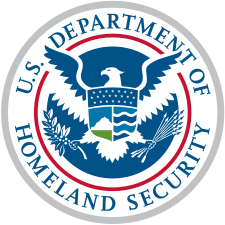Help us improve in just 2 minutes—share your thoughts in our reader survey.
Immigration and Customs Enforcement
| U.S. Immigration and Customs Enforcement (ICE) | |
 | |
| Annual budget: | $9.1 billion (FY2024) |
| Total employed: | 21,000 |
| Year created: | 2003 |
| Official website: | https://www.ice.gov |
U.S. Immigration and Customs Enforcement (ICE) is the agency in the executive branch of the federal government that enforces immigration and customs laws. ICE is a division of the U.S. Department of Homeland Security (DHS), a United States executive department formed in 2002 to "safeguard the American people, our homeland, and our values," according to its official website. ICE is responsible for investigating transnational crime and identifying, detaining, and deporting individuals who violate U.S. immigration laws. While Customs and Border Patrol (CBP) primarily handles border security, ICE is deployed across the domestic U.S. and overseas. [1]
History
When the Homeland Security Act of 2002 created the U.S. Department of Homeland Security, it created the Bureau of Immigration and Customs Enforcement—now known as U.S. Immigration and Customs Enforcement—within the DHS. ICE formed when the former U.S. Customs Service and the former Immigration and Naturalization Service merged during the shaping of the DHS. While ICE focuses on the enforcement side of United States immigration laws, U.S. Citizenship and Immigration Services administers the legal immigration process.[3][4]
Work
| Administrative State |
|---|
| Read more about the administrative state on Ballotpedia. |
In 2025, ICE employed 21,000 people in all 50 states and in 55 foreign countries, according to its website. ICE serves as the main investigative arm of the DHS.[5]
Mission
According to its official website, the following is the ICE mission:
| “ | Protect America through criminal investigations and enforcing immigration laws to preserve national security and public safety.[3][6] | ” |
Duties
ICE's responsibilities include disrupting transnational criminal organizations that exploit U.S. borders and preventing terrorism by enforcing and administering customs and immigration laws. ICE's primary functions are split between two divisions: Enforcement and Removal Operations (ERO) and Homeland Security Investigations (HSI). The Office of the Principle Legal Advisor (OPLA) is another division that supports the ICE mission.[3][7]
Enforcement and Removal Operations
ERO aims to "identify, arrest, and remove aliens who present a danger to national security or are a risk to public safety, as well as those who enter the United States illegally or otherwise undermine the integrity of our immigration laws and our border control efforts."[8]
Homeland Security Investigations
HSI targets "criminal organizations illegally exploiting America's travel, trade, financial and immigration systems."[9]
Office of the Principal Legal Advisor The OPLA is the largest legal program within the DHS. The office represents the government of the United States in cases regarding exclusion, deportation, removal, and other immigration cases involving terrorism, criminal aliens, and human rights abusers. In addition, OPLA helps ICE with issues such as customs, worksite enforcement, ethics, employment law, and administrative law.[10]
Employment
The Best Places to Work in the Federal Government is a website that tracks workforce trends in federal agencies. ICE ranked number 418 out of 432 federal sub-agencies as of February 2024. The metrics used in this ranking included leadership, pay, innovation, and support for diversity.[11]
Leadership
Todd M. Lyons began service as the acting director for U.S. Immigration and Customs Enforcement in 2025.
Recent news
The link below is to the most recent stories in a Google news search for the terms 'U.S. Immigration and Customs Enforcement'. These results are automatically generated from Google. Ballotpedia does not curate or endorse these articles.
See also
External links
- Official U.S. Immigration and Customs Enforcement website
- U.S. Immigration and Customs Enforcement on Twitter
- U.S. Immigration and Customs Enforcement on Facebook
- U.S. Immigration and Customs Enforcement on YouTube
- U.S. Immigration and Customs Enforcement on Linkedin
- U.S. Immigration and Customs Enforcement on Instagram
Footnotes
- ↑ Department of Homeland Security, "Our Mission," accessed June 26, 2025
- ↑ Department of Homeland Security, "Fiscal Year 2025 Congressional Justification" accessed June 26, 2025
- ↑ 3.0 3.1 3.2 U.S. Immigration and Customs Enforcement, "U.S. Immigration and Customs Enforcement (ICE)," accessed February 27, 2024
- ↑ U.S. Immigration and Customs Enforcement, "History of ICE," accessed June 29, 2016
- ↑ Department of Homeland Security, "Fiscal Year 2025 Congressional Justification" accessed June 26, 2025
- ↑ Note: This text is quoted verbatim from the original source. Any inconsistencies are attributable to the original source.
- ↑ Cite error: Invalid
<ref>tag; no text was provided for refs namedFY17 - ↑ U.S. Immigration and Customs Enforcement, "Enforcement and Removal Operations," accessed June 29, 2016
- ↑ U.S. Immigration and Customs Enforcement, "Homeland Security Investigations," accessed June 29, 2016
- ↑ U.S. Immigration and Customs Enforcement, "Office of the Principal Legal Advisor," accessed June 30, 2016
- ↑ The Best Places to Work in the Federal Government, "Agency Report: Immigration and Customs Enforcement (DHS)," accessed February 27, 2024
| ||||||||||||||||||||||||||||


